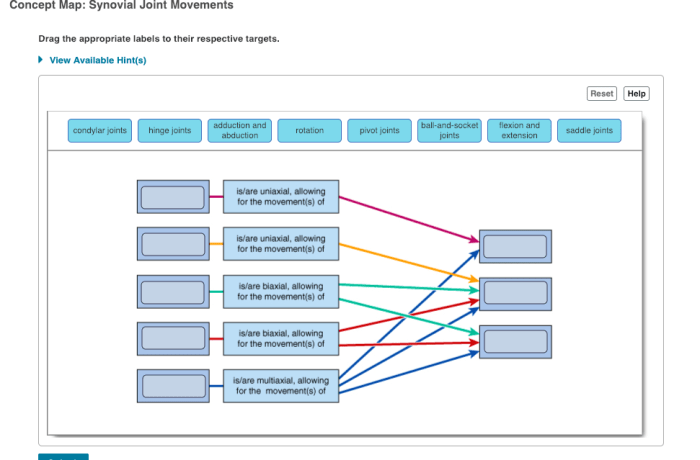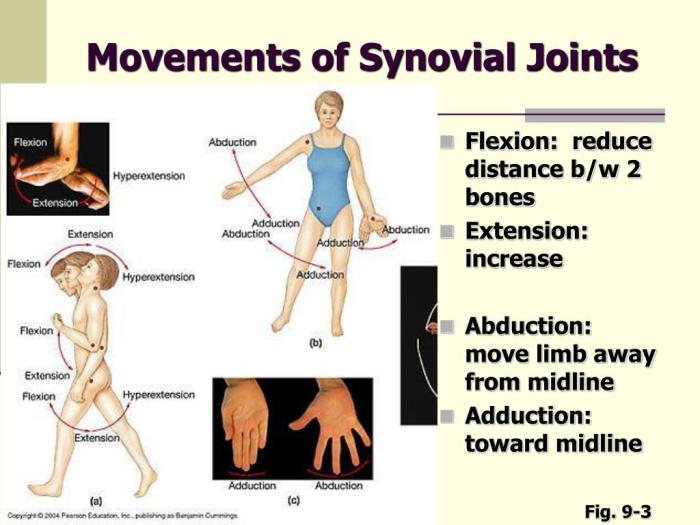Concept map synovial joint movements unveils a systematic approach to understanding the intricate connections between synovial joint types, their movements, and the associated anatomical structures. This innovative tool empowers healthcare professionals and students alike to delve into the realm of joint biomechanics with unprecedented clarity and precision.
As we delve into the concept map, we will explore the diverse types of synovial joints, from the hinge joint’s simple flexion and extension to the ball-and-socket joint’s remarkable range of motion. We will unravel the mechanics of synovial joint movements, elucidating the role of muscles, tendons, and ligaments in orchestrating these intricate actions.
Introduction: Concept Map Synovial Joint Movements

Synovial joints are the most common type of joint in the human body. They are characterized by their smooth, gliding surfaces and their ability to move freely in a variety of directions. Concept maps are a tool for organizing and visualizing information.
They can be used to analyze synovial joint movements by showing the relationships between different types of joints, their movements, and the associated anatomical structures.
Types of Synovial Joints
- Hinge jointsallow for flexion and extension, such as the knee and elbow joints.
- Pivot jointsallow for rotation, such as the joint between the first and second cervical vertebrae.
- Condyloid jointsallow for flexion, extension, abduction, and adduction, such as the wrist joint.
- Saddle jointsallow for flexion, extension, abduction, adduction, and circumduction, such as the thumb joint.
- Plane jointsallow for gliding movements, such as the joints between the vertebrae.
- Ball-and-socket jointsallow for flexion, extension, abduction, adduction, rotation, and circumduction, such as the hip and shoulder joints.
Mechanics of Synovial Joint Movements
Synovial joints are able to move freely due to the presence of synovial fluid, which lubricates the joint surfaces. Muscles, tendons, and ligaments work together to facilitate joint movements. Muscles contract to pull on tendons, which are attached to bones.
This causes the bones to move at the joint. Ligaments help to stabilize the joint and prevent it from moving in unwanted directions.
Concept Map of Synovial Joint Movements
A concept map of synovial joint movements can be used to illustrate the interrelationships between different types of joints, their movements, and the associated anatomical structures. The concept map can be organized using appropriate shapes, colors, and connectors to enhance clarity and understanding.
Applications of Concept Maps in Synovial Joint Analysis, Concept map synovial joint movements
- Concept maps can be used to identify patterns and relationships in synovial joint movements.
- They can be used to develop rehabilitation plans for individuals with joint injuries or disorders.
- They can be used to improve understanding of joint biomechanics and movement optimization.
Limitations and Future Directions
One limitation of using concept maps for synovial joint analysis is that they can be complex and difficult to create. Another limitation is that they may not be able to capture all of the нюансы of joint movement. However, concept maps can be a valuable tool for understanding synovial joint movements and can be used to improve rehabilitation and treatment plans.
User Queries
What are the advantages of using concept maps in synovial joint analysis?
Concept maps offer a structured and visual representation of complex relationships, enhancing comprehension and facilitating the identification of patterns and connections.
How can concept maps aid in rehabilitation planning for joint injuries?
Concept maps provide a comprehensive overview of joint movements and associated structures, enabling practitioners to tailor rehabilitation programs that target specific movement impairments.
What are the limitations of using concept maps in synovial joint analysis?
Concept maps may not capture the full complexity of joint biomechanics and may require validation through empirical studies.


